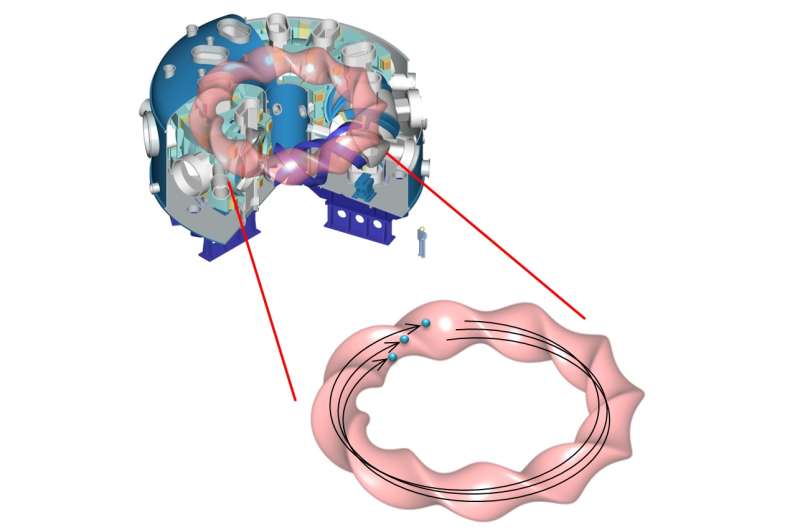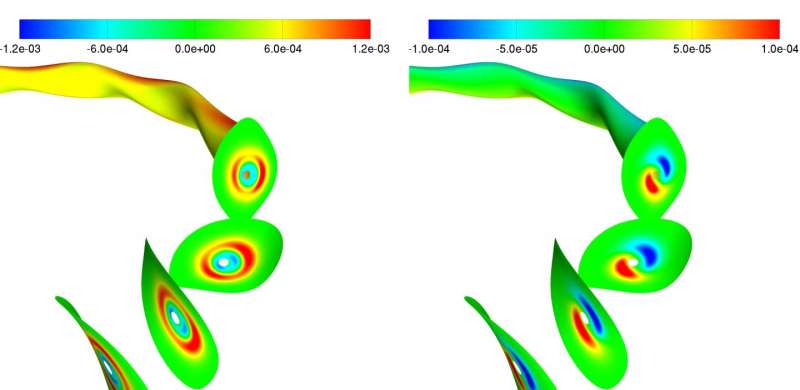Clarifying plasma oscillation by high-energy particles

The National Institute for Fusion Science has developed new code that can simulate the movement of plasma and, simultaneously, the movement of particles circulating at high speeds. In the Japanese fusion reactor called the Large Helical Device (LHD), researchers have investigated plasma oscillations induced by high-energy particles. New research results, along with the data obtained from LHD experiments, have clarified the details of oscillations that cannot be measured by experiments and the interaction of high-energy particles and their oscillations.
High-energy alpha particles (helium ions), generated by fusion reactions using deuterium and tritium, heat the plasma and maintain the high temperature conditions necessary for fusion reaction. The prediction of their behavior and their control are the keys for maintaining the fusion reaction. On the other hand, plasma is also a fluid that conducts electricity. And because flow of electric current produces a magnetic field, this is called magnetofluid, or magnetohydrodynamic fluid.
Plasmas that are magnetofluid oscillate. When the oscillation period and the period of high-energy alpha particles circulating inside a plasma match, there is a possibility that the oscillation amplitude will increase due to resonance. As a result, because high-energy alpha particles escape the plasma, there is concern that the performance of the fusion reactor will degrade. In order to realize the generation of fusion electricity, it is imperative to make highly reliable predictions regarding the distribution of high-energy particles that incorporate the plasma's interaction with oscillations.
The research group led by Professor Yasushi Todo and Assistant Professor Hao Wang of the National Institute for Fusion Science (NIFS) has developed a program that can simulate the plasma behavior and the movements of high-energy particles (The program is called "hybrid simulation" because it connects fluid and particles). It is now possible to simulate the interaction between plasma oscillation and high-energy particles, which was not possible by previous methods that calculated the plasma and the high-energy particles separately.
Using this hybrid simulation program on supercomputers—NIFS's plasma simulator and Helios, of the International Fusion Energy Research Centre—the researchers conducted a large-scale simulation of LHD plasma. In the LHD experiments, they conducted research on high-energy particles and plasma oscillations using high-energy particles generated by neutral beam injection (see Fig. 1). In the simulation results shown in Figure 2, together with the experimental data for plasma oscillations that are caused by the high-energy particles, they clarified the details of oscillations that cannot be measured by experiment, as well as the interaction of high-energy particles that cause the amplification of oscillation.
This hybrid simulation program is appropriate not only for the LHD but also for fusion plasma experiments in Japan and abroad. By comparing the experimental results regarding the distribution of high-energy particles and oscillations, the reliability of the program has been confirmed. By successfully reproducing the LHD experiment, the researchers have produced the first program that can simulate high-energy particles and plasma oscillations.

This research result was announced at the 26th International Atomic Energy Agency conference held October 17-22 in Kyoto, Japan.
Using the Hybrid Simulation Program developed by the National Institute for Fusion Science, the prediction accuracy of high-energy alpha particle distribution in fusion reactor core plasma has significantly improved. This will contribute to the development of highly reliable operation scenario and design of fusion reactors, and could speed the achievement of a fusion reactor. In addition, the work contributes to the understanding of the interactions of high-energy particles and oscillations. While the oscillations of plasma cause the loss of high-energy particles that heat plasma, the oscillations, by providing plasma with energy received from high-energy particles, conversely heat plasma.
Provided by National Institutes of Natural Sciences



















